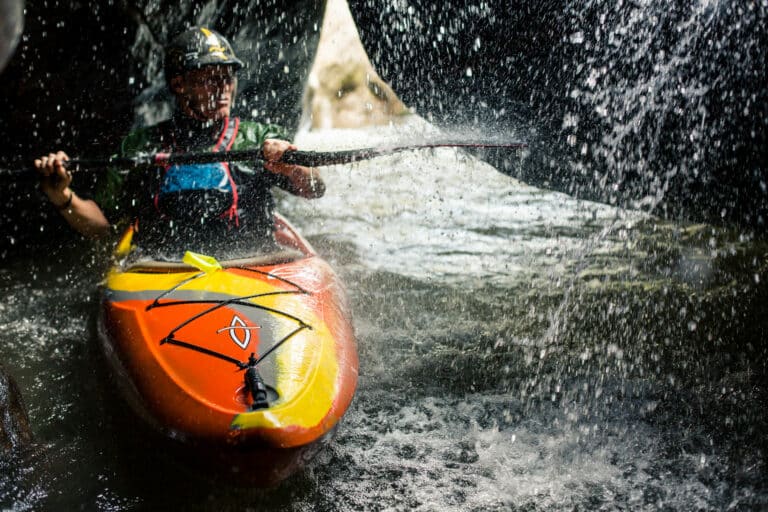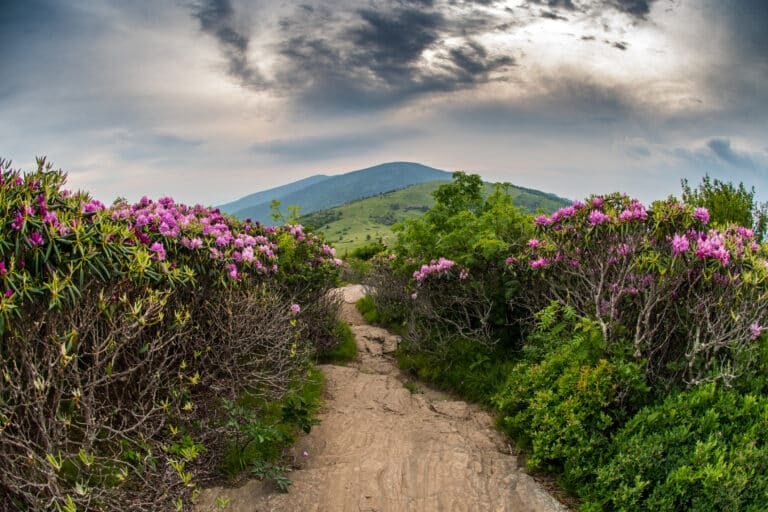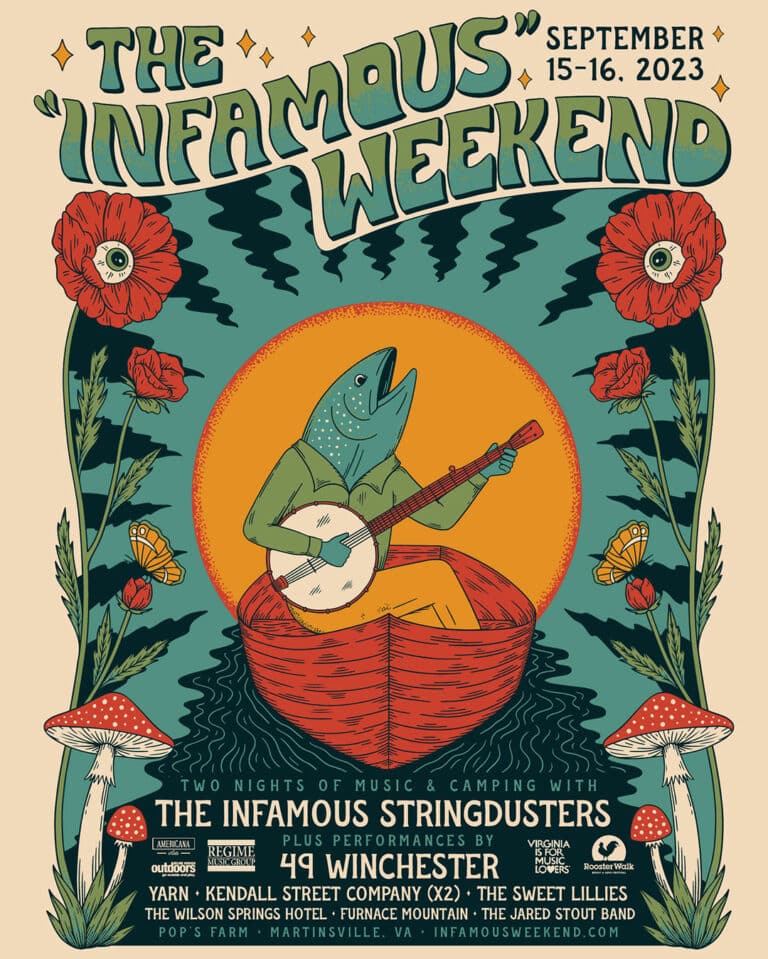Some of the region’s best backcountry skiing is found on a mountain once slated for a ski resort
A handful of guys with guns strapped to their shoulders are hovering around the trailhead. They have thick beards and orange hats. They’re laughing and drinking coffee. When we drive up, they get quiet.
It’s the first day of bear season in West Virginia. It’s also the day after the first big snowstorm of the season. The Lake Effect dropped almost a foot on the Alleghenies in a single day.

We’re hoping to ski Mount Porte Crayon, one of the highest mountains in West Virginia. Mount Porte Crayon was at one time poised to be the greatest ski resort south of Vermont. Plans fizzled, but the legend of Mount Porte Crayon’s skiable terrain survived. Some say the top of the mountain gets far more snow than nearby Canaan Valley, simply because of its superior elevation. Several leading backcountry skiers have called Porte Crayon the snowiest mountain in West Virginia. The mountain has an almost mythical status in backcountry ski cultures.
I’ve driven eight hours through the night to arrive at Porte Crayon’s trailhead and find out for myself if the legends are true.
Mount Porte Crayon. Even the name sounds epic—like something out of a Krakauer book. The mountain peaks at 4,770 feet, making it the highest point on the Roaring Plains, a string of roundish, high-elevation meadows with one-sided trees deformed by heavy winds. Sitting across Highway 19 from Dolly Sods, Porte Crayon is only a few miles from Canaan Valley, an epicenter for backcountry touring, but it stands a good 400 feet taller than any of the mountains popping out of that snowy valley.
The top of the mountain is a mix of thick spruce and hardwoods that give way to expansive, sweeping plains stretching to the east. Most of the higher elevations surrounding Porte Crayon are part of the Monongahela National Forest, including the new Roaring Plains Wilderness expansion. Hikers say Porte Crayon is a wilder version of Dolly Sods. Locals say this is where the last known wolf in West Virginia was shot.
The mountain is divided between public land and privately owned, fenced parcels owned by horse farmers and second home developers. A cleared gas pipeline traverses the north side of the mountain, dropping from 4,500 feet in elevation to roughly 2,500 feet at Red Creek. And on either side of this narrow, grassy opening are steep, skiable tree-lined bowls that suck the snow off the top of the mountain, according to local skiers.
Robert Jaquay’s brother bought a cabin at the bottom of Mount Porte Crayon in the ‘80s, and the two of them have been skiing the various knobs, plains, and bowls that rise from their backyard ever since.
“I used to spend a lot of time exploring other areas of West Virginia for backcountry skiing,” Jaquay says. “But once my brother bought that cabin, I knew I found my own personal Shangri-La.”
The few skiers who attempt to ski Porte Crayon usually stick to the pipeline because it’s easy to navigate and predominantly on public land. Just point your skis downhill and let it rip. But Jaquay likes the Bearpen Bowl better. It’s a heavily-treed slope that starts at 4,400 feet and drops to 3,400 feet on public land, then drops another 1,000 vertical feet on private land.

Jaquay has stories about skiing every corner of Mount Porte Crayon. He talks about skiing between the rocks of Flatrock Cliffs after a huge storm, or dropping down Big Run Ravine into Laneville, or hitting extreme tree lines on either side of the pipeline. Other skiers who’ve sampled Porte Crayon tell stories about getting snowmobiles stuck in massive drifts off the pipeline and skiing shaded bowls well into April.
The underlying theme of these tales is always the same: the snow on Mount Porte Crayon is unlike anywhere else.
That’s what led Frank Jorgenson and Bright Enterprises to focus on Mount Porte Crayon for the Almost Heaven Resort.
“We kept hearing anecdotal evidence of the snow on Mount Porte Crayon, so we decided to put weather instruments in several sites all over the mountain to determine exactly what we were looking at,” says Jorgenson, the president of Bright Enterprises, the company that owns Winterplace Resort near Beckley, W.Va.
Jorgenson collected weather data for two years on Mount Porte Crayon and discovered that the local tales of backcountry powder were largely true.
“We found that Porte Crayon does hold snow longer than other mountains in the area, and that there was a real difference in the amount of snow that fell at the top of the mountain as opposed to the resorts that surrounded it,” Jorgenson says.
Porte Crayon has all the right ingredients for a resort: an average of 150 to 200 inches of snow a year, a unique hollow shape that helps push much of the windblown snow onto the northern slopes, and big vertical drop.
“From top to bottom, we were looking at a true 2,200 foot vertical drop, making it the sixth largest vertical drop at a resort east of the Rockies, with weather similar to southern Vermont,” Jorgenson says. “It would have been the largest resort south of Lake Placid, New York.”
Bright Enterprises started buying up land on Porte Crayon over a decade ago. The plan called for a 2,000-acre resort with more than 2,000 feet of vertical drop on a north-facing slope that got plenty of natural snow. Skiers salivated over the prospect of skiing that kind of terrain below the Mason Dixon, while environmentalists cringed at the thought of a mountaintop village, golf course, and second home development scarring the pristine landscape.
For ten years, a debate brewed with locals and skiers coming down hard either for or against Almost Heaven. Eventually, Bright Enterprises failed to purchase a significant piece of private land at the top of the mountain, and resort plans fell apart.
As we hike Porte Crayon all the way to the ridgeline where the snow is sure to be the deepest, we climb 2,700 feet…in ski and snowboard boots. It’s a prospect that makes us think that a lift-served resort on the side of the mountain wouldn’t be too bad. But then, Almost Heaven might have been an environmental disaster.

The summit of Porte Crayon is home to a rare native red spruce forest, as well as the endangered northern flying squirrel and cheat mountain salamander. It gives birth to three key mountain rivers. This mountain summit is so ecologically sensitive, it’s been set aside by the forest service as a Research Natural Area. The Nature Conservancy has named it one of the most biologically and ecologically diverse areas in West Virginia. They’re planning a massive 1,800-acre preserve on its western slope. And even though the mountain gets a healthy serving of natural snow, Almost Heaven would have had to employ snow-making machines, which would have meant pulling water from one of the pristine rivers at the bottom of the mountain. And then you have the requisite power lines that would have probably had to cross forest service land.
“In a worst-case scenario, Almost Heaven would have been similar to Snowshoe, with a mountaintop development,” says Jonathan Jessup, a nature photographer who used his images to raise awareness about the resort plans on Porte Crayon for the West Virginia Highlands Conservancy. “Ski resorts derive most of their income from residential development. If you’ve been to Deep Creek Lake and seen how developed that area is, that’s what we wanted to avoid.”
Even some local skiers didn’t like the idea of turning Porte Crayon into a legitimate resort. “There are two other resorts about nine miles away that have trouble keeping people on their slopes. What makes anyone think a third one would survive?” asks Tony Barnes, a skier and climber who lives at the bottom of Porte Crayon. “Beside, Mount Porte Crayon is big and wild. I’d like to see it kept that way.”
Picture a golf course, mountaintop Starbucks, wide-open groomed trails and half-million-dollar cabins spread across Mount Porte Crayon, and the mountain loses some of its cache. Aside from the epic powder and serious vert, what makes Porte Crayon so attractive is that it takes more effort to ski than other backcountry destinations. Without a shuttle or permission to access private property, you have to climb a good 2,000 vertical feet on foot to reach the deep snow. Once you’re at high elevation, it’s up to you to navigate to the powder stashes. There are no trail signs, no named bowls. And then you’ve got to be good enough to make it back down the mountain in one piece.
“There’s no resort infrastructure around Mount Porte Crayon, so you don’t see anyone,” says John Regan, a skier from Garrett County, Md., who spends much of his winters exploring the backcountry of West Virginia. “Most people aren’t into the true backcountry stuff. They want groomed trails and lunch at the lodge. There’s good backcountry stuff in Canaan Valley and Garrett County that’s easy to access. But Porte Crayon is wild and exotic.”
Porte Crayon is so wild and exotic that in the decades Robert Jaquay has been skiing the mountain, he’s never come across another skier.

Hiking up Porte Crayon’s ridge, I begin to understand why. I can see babyhead-sized rocks and thick deadfall sticking out of the snow between the hardwoods. Here on the ungroomed north face of wild Mount Porte Crayon, even the 10 inches of fresh snow that fell two days ago isn’t enough to make this rocky terrain skiable.
“Porte Crayon doesn’t ski until you’ve got a bomber base of eight to ten inches of packed snow,” Jaquay explains.
That packed snow base doesn’t develop until several snowstorms have worked their freeze-thaw magic, usually some time in January or February. Yes, big mountain backcountry skiing exists in the Southeast, but consistent backcountry skiing is a different story. Consider this the fine print underlining all the skier tales of four-foot powder stashes: those stashes are fleeting. Even on micro-climates like Mount Porte Crayon and Pharis Knob, timing is everything.
“You have to strike while the iron’s hot,” says John Dalen, a long-time West Virginia backcountry skier. “You might have it really good one day, and the next day, it’s 40 degrees and raining. You can never pass an opportunity to ski the backcountry.”
Veteran skier Shawn Hash compares backcountry skiing in the Southeast to gambling. “You take a risk to drive to a mountain in the middle of West Virginia because you think there’s going to be enough snow to ski. But you’ve got to take that risk. You’ve got to go. And when you go, you rarely get burned.”

Sometimes, though, you do get burned. Sometimes, you drive eight hours to hit a storm and ski an epic mountain, but the timing is off, and instead of backcountry turns, you have a pretty hike in a forest thinly covered with snow. You may feel like an idiot, unloading your skis while bear hunters smirk. You may hurt yourself trying to force a few turns out of snow that’s simply too thin to ski. You may gamble and lose, but you go back home to watch the weather again. You wait for another storm to develop so that you can gamble one more time, just for the chance that you’ll hit the perfect mountain, on the perfect day, with the perfect amount of snow. •
ANOTHER SECRET STASH
Blacksburg’s Shawn Hash spends his winters looking for big backcountry downhill opportunities. He has found untracked powder on the edge of Canaan Valley, carried an injured dog off Porte Crayon, skied serious vert on Spruce Knob, hucked cornices above the Sinks of Gandy, and found runs off the Parkway in Floyd County, Va., that he swears have a 1,000-foot vertical drop.
“Nobody believes me when I tell them there’s good backcountry downhill in the South,” Hash says. “I can show them pictures of us skiing powder, and they still don’t believe me.”
Hash’s favorite destination for remote downhill turns is a privately owned mountain in the Upper Sinks of Gandy called Pharis Knob. The mountain peaks at 4,675 feet with a big, tree-filled hollow on the north face that catches snow blown from the exposed plains near the summit. Pharis has all the stats you need for serious backcountry vert: at least 160 inches of snow a year, 1,100 vertical drop at high elevation on a north-facing slope.
“It is the best backcountry skiing in the east, hands down,” Hash says. “Factor in the terrain, elevation, snow, and you’ve got all the ideal elements wrapped into one.”
Perhaps more importantly, Pharis Knob is owned by John Dalen, a life-long backcountry skier who grooms that upper 1,100 foot drop for tree skiing. The knob has been in Dalen’s family since just after the Civil War and has been skied consistently by the last three generations of Dalens. Over the summer, John and friends like Hash have manicured the north-facing hollow, removing rock and deadfall in order to get more skiable days on the mountain. As is, Dalen estimates he can get anywhere from 60 to 100 skiable days on Pharis, depending on the winter.
Dalen has considered turning the mountain into a privately-owned recreation area, but doesn’t believe there would be enough skier interest to keep the mountain open during the winter. During the heaviest snows, skiers would have to hike 12 miles to the summit because the county doesn’t plow the roads at the base. However, Dalen has recently purchased a snowcat and will test out shuttle-run possibilities with his friends this winter.
“My skiable terrain is 500 feet higher than anything else around,” Dalen says. “The middle of Pharis is the same elevation as the top of the mountains in Canaan Valley. Sometimes, I’ll hike up from my cabin at 3,500 feet on bare ground, then have four feet of snow at the top of the mountain.”







